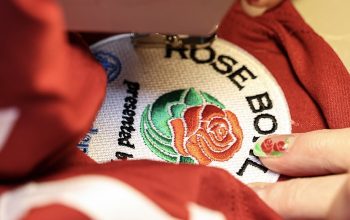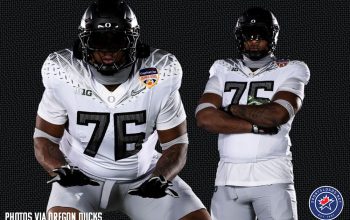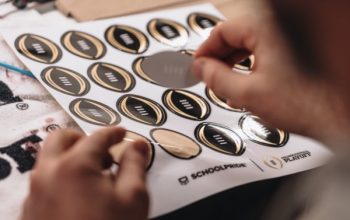The University of Richmond’s athletic teams have been nicknamed the Spiders since 1894, when a Richmond Times-Dispatch newspaper reporter named Ragland Chesterman made an observation that would have a long-lasting impact.

“There was a star pitcher named Puss Ellyson, and they said his lanky arms and stretching kick confused batters,” said Jana Ross Woodson, Richmond’s Assistant AD of Marketing and Fan Development. “The writer for the Times-Dispatch used the name of The Spider to describe him and the members of his team.”
(I’ll say it so you don’t have to: If the origin of your team’s nickname is a guy named Puss, “Spiders” was about as good an outcome as you could have hoped for.)
The nickname is unique in the literal sense of the word—the Richmond Spiders are the only ones in North America. According to the university’s website, “To this day, the University of Richmond is the only school in the country which sports the nickname ‘Spiders.'”
The university might be able to expand that claim beyond just colleges and universities. I’ve not been able to find any professional Spiders either, though there is an amateur Scottish football club called the Queen’s Park Spiders.
If you go back far enough, there was a time when the University of Richmond went by a different name. “From 1876 to ’93, Richmond carried the nickname of the Colts,” Woodson said. The reason for that nickname, according to the school’s website, is that their baseball team resembled an “energetic team of young colts,” which is about as generic and lukewarm a reason you could give for that sort of thing.
Though the origin story of the Spiders nickname is extremely specific, it is not well known. I asked Ms. Woodson if she thought current students would know where the nickname came from.
“I don’t think many of them would,” she said. “I don’t think it’s a really common thing, especially since it’s from the 1800s…. It’s definitely part of our history, but it’s probably a part of our history that not everyone, unless you’re really entwined with the university or work here like I do, knows.”
But even if the story behind the nickname is not well known, the nickname itself is. The University of Richmond is a small school, with just over 3,000 undergraduates, and it has had minimal success in athletics. The Spiders football team won the 2008 Division 1-AA (now stupidly called the Football Championship Subdivision) championship, the basketball team was the first 15-seed ever to win an NCAA tournament game in 1991, and the baseball program has produced such Major League players as Brian Jordan and Sean Casey.
But even if the Spiders are not exactly an athletic powerhouse, the nickname is memorable. “I think that’s just because of the uniqueness of it,” Woodson said. “It resonates and people recognize us.”
And because the name’s been around for 120 years, people don’t think to ask where it came from. “Most of the time, we don’t get ‘Why Spiders?’” Woodson said. “Most of the time we get, ‘Oh yeah, Richmond, that’s the Spiders!’”
The mascot itself has evolved over the years, from the adorable but arachnologically suspect six-legged mascot back in the early 1990s (unofficially named “Spidey” until Marvel Comics unofficially voiced its unofficial displeasure with that), to the frat guy in sweats and a cape with a spider head in the late ’90s and early 2000s, to WebstUR (get it?), who was introduced in 2011.
Before WebstUR was introduced, the university community held an online vote to decide between one of the designs above by Rickabaugh Graphics, or to stay with the frat guy in the cape. The one on the left won, even though the one on the right (what I think of as Teenage Mutant Ninja Spider) had built-in rocket launchers on its arms.
 As many universities and colleges do, the academic institution has its own logo, distinct from the athletic mark. “From a branding standpoint, athletics-wise, we always use the silhouette spider,” Woodson said, “but the university, for things that are a little more academic and collegiate and things of that nature, they use the shield.”
As many universities and colleges do, the academic institution has its own logo, distinct from the athletic mark. “From a branding standpoint, athletics-wise, we always use the silhouette spider,” Woodson said, “but the university, for things that are a little more academic and collegiate and things of that nature, they use the shield.”
The primary athletic logo, a silhouette of a spider, is not based on a specific species, according to Woodson, but does have one defining characteristic. “It’s obviously evolved over the years,” she said. “This one is kind of the hairy spider.”
I set about trying to find what species of spider Richmond’s is, so I put the question to a group of naturalists and environmental educators. The consensus was that it doesn’t look like any specific species of spider, and in fact it looks more like a tick than a spider. So that answers that.
Logo enthusiasts might notice that Richmond’s athletic logo bears a resemblance to that of the athletic gear company Spyder, even though Spyder’s logo is a specific species (the red hourglass marks it as a black widow) and is smooth rather than hairy. After some legal wrangling about a decade ago, the university and the company arrived at an agreement.
 “We have just the plain silhouette spider, which can be used on all our athletic gear and official team gear and things of that nature by itself,” Woodson said. “But when it goes onto apparel to sell, from a royalties and a licensing standpoint and things of that nature, it’s got to have ‘Richmond’ or a ‘UR’ attached to it.”
“We have just the plain silhouette spider, which can be used on all our athletic gear and official team gear and things of that nature by itself,” Woodson said. “But when it goes onto apparel to sell, from a royalties and a licensing standpoint and things of that nature, it’s got to have ‘Richmond’ or a ‘UR’ attached to it.”
With all of this being said, I am compelled by journalistic integrity to mention that I am a Spider myself. As a student back in the 1990s, I enjoyed our unique nickname, but even as one who was fairly active with the athletic programs (okay, I played trumpet in the pep band), I can be counted among those who did not know why we were called the Spiders until years after I graduated.
The nickname stands on its own because it is unique and fun, but knowing that it has its origins in a metaphor that a reporter used to describe a gangly baseball player in the 1800s makes it that much more interesting. I only wonder what Puss Ellyson would have thought if he could have looked 120 years into the future and seen the long-lasting effects of Ragland Chesterman’s observation about his gangly legs.

















